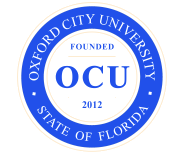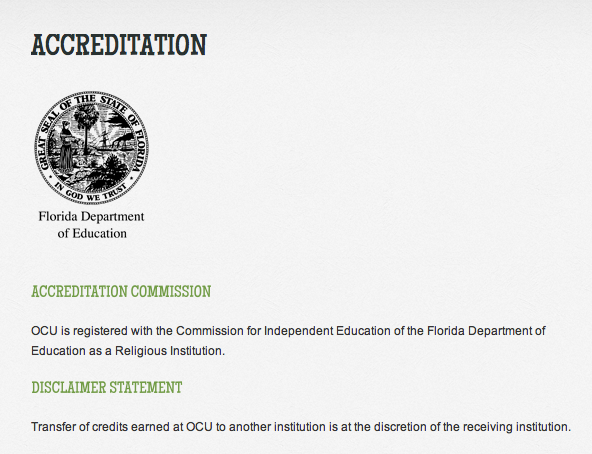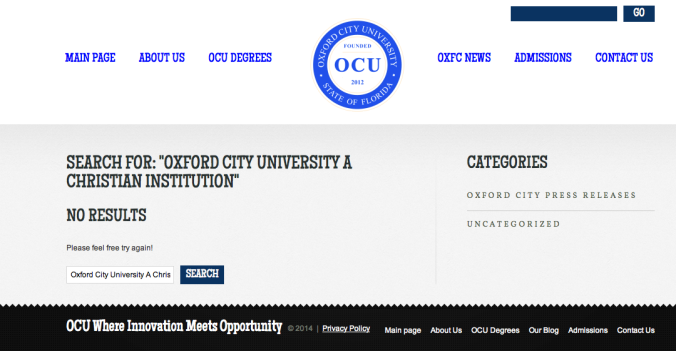Always on the look-out for a case study, I was intrigued by a story in February 2014 in the Oxford Mail about a ‘university’ being set up with the name ‘Oxford City University’. Thomas Guerriero, part-owner of Oxford City Football Club, had established this university and was lending the name of the club to it. It is clear that the University of Oxford has to keep an eye out for infringements of its trade-mark, and the story focused on that. A month later, the Oxford Times reported that Guerriero had accepted that he couldn’t call it that.

The regulation of higher education is complex in US and there are challenges to the robustness of regulation of colleges in several states. Florida is an interesting example. There is a Commission For Independent Education which has oversight of colleges. The Commission’s remit excludes religious colleges. It allows that colleges can run as religious colleges if they meet the following criteria.
1. The name of the institution includes a religious modifier or the name of a religious patriarch, saint, person, or symbol of the church.
2. The institution offers only educational programs that prepare students for religious vocations as ministers, professionals, or laypersons in the categories of ministry, counseling, theology, education, administration, music, fine arts, media communications, or social work.
3. The titles of degrees issued by the institution cannot be confused with secular degree titles. …
Now, it turned out that Oxford City University was claiming to be a religious college:

That sentence about accreditation could be misconstrued. What Oxford City University had was an exemption from having to be accredited – and furthermore it was known to Florida’s Education Department as Oxford City University – a Christian Institution. Back in February 2014, however, there was no mention of Christianity on its website. I know, I checked…

Although it changed its name to CIT University, it was still a university where innovation met opportunity. In April 2015 it was announced that it was ready to launch its masters degree in sports management. The press release said:
… with a tuition of only $9,900 per year for the Masters Degree program, the company hopes to take on approximately 10,000 students in the first year. There is no assurance, however, that the company will be able to meet that projection. However, with 10,000 students at a tuition of $9,900 USD, the company could realize approximately $99 Million in revenue. We are anticipating to have operational and partnership costs of approximately 50% of the tuition. So, if the plan works out, this would put the company in a position to potentially have $45 Million in net profit from tuition only.
For those of us plodding along in traditional universities, it is clear that we are simply not ambitious enough – a single masters course with $99 million in revenue. That’s good news for investors – but there was good news for the students too:
The company also plans to create a unique capstone model where students will share in a 50% split of the net profit of their capstone project. All students will need to show competency of the coursework by applying it in a project and will successfully graduate upon executing a plan with one of Oxford City’s 5 professional sports teams to generate a minimum net profit of $20,000. Some students, therefore, may leave the program debt free. For those students that show a level of innovation that generates a significant and sustainable revenue stream they may earn a position with the company straight out of school to lead that project as a Director with the company.
Immediately the share price in the company jumped 10 fold (to $0.10). It needed some good news, the Company had reported it had incurred some losses since inception and now had a ‘cumulative retained deficit of $17,468,089 as of March 31, 2015′. A proportion of that had gone on ‘officer compensation’ which was $7,067,337 in that year.
But it came as a bit of a shock in December to discover that Thomas Guerriero had been arrested. He was held in jail over Christmas, charged by the Securities and Exchange Commission for investor fraud.
The SEC set out the allegations in detail, including the tactics to ‘persuade’ investors to join up, but this is the section relating to the university from their complaint:
Defendants also misled investors about the success and profitability of Oxford City University, the purported online college in the U.S. and the cornerstone of OXFC’S Academic Portfolio. OXFC Business Plans that were sent to investors over the relevant period projected profits from its universities of $495 million in profit over a five-year span.
In an email to one investor, Guerriero elaborated: We anticipate in 5 years to get to over 15,000 students. This would bring our revenue to over $ 150 Million. We anticipate operating at a 90% profit, which is $135 million per year. So by Year 5 we anticipate generating over $500 million in net profit.
OXFC has no track record of profits from any academic programs during its existence. In fact, over the relevant period, OXFC’s public filings never reported any revenue from any academic institution. Yet Defendants were projecting profits that would have made it one of the largest, if not the largest, for-profit university in the United States.
The allegation here is that the people being ripped off were not students, as there were no students, but investors. Clearly the evidence presented by the SEC appears to be an extreme case, and one more for financial regulators than academic ones, but it is an interesting sign of the vigilance that will be needed around for-profit education.
Update:
In May 2016 Guerriero was jailed for 12 years – see Oxford Mail report
Pingback: Finding more HE provision in Oxford | moremeansbetter